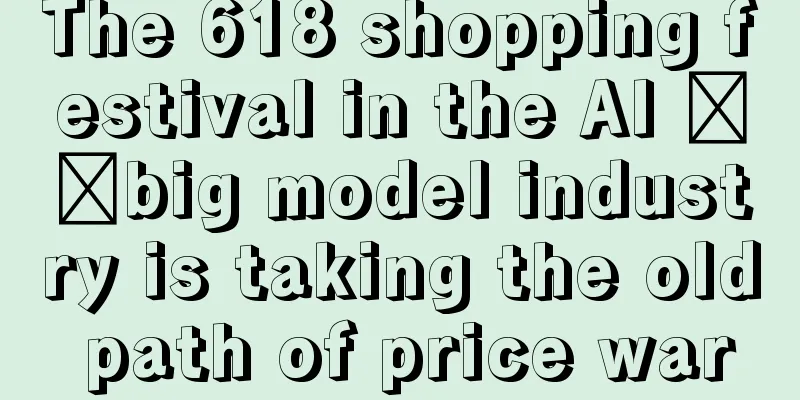The 618 shopping festival in the AI big model industry is taking the old path of price war

Whether AI developers are willing or not, the domestic large-scale model industry dominated by Internet companies has returned to the Internet-style "free" logic of ten years ago. The decision-making power of commercialization has shifted - when to kill the chicken and when to "take the eggs" is no longer up to them. No one expected that the first shot of 618 in 2024 would not be initiated by any of the e-commerce companies "Maogou Pindou", but by a large model manufacturer instead. Half a month ago, Volcano Engine took the initiative and announced that the price of Doubao's main model in the enterprise market was 0.0008 yuan/thousand tokens, which was 99.3% cheaper than the industry. A week later, mainstream domestic large model manufacturers such as Baidu, Alibaba Cloud, and iFlytek all announced that their main models were completely free. Since then, the price war of large models with free as a gimmick has formed a domino that cannot be "reversed" in the short term. If we look back at the growth process of previous Internet sub-industries, most of the time they have experienced free rides during the growth period and subsidy period in exchange for market size and number of users. When the product ecosystem matures and binds enough users and industrial chains that make a living from it, the price will be raised to complete the harvest. So far, the big model has gone through the first year of birth and compliance, and is entering the second stage characterized by price reduction. The only difference is that the main price reduction targets of the big model are still mainly enterprise-level users and application-layer developers. For individual users, except for the upgraded services of some manufacturers that require membership subscription, it is still completely free. In other words, for large models and related products, the commercialization process has not really started for the C-end users that they really want to cover. For most developers, the more intense the price war between manufacturers, the lower the product development cost for them. However, once a dependence on a certain manufacturer is formed, once the product price increases in the future, this not only means extremely high exit costs, but also whether the ROI (return on investment) can return to normal may be a problem. Whether AI developers are willing or not, the domestic large-scale model industry dominated by Internet companies has returned to the Internet-style business logic of ten years ago. The decision-making power of commercialization has shifted - when to kill the chicken and when to "take the eggs" is no longer up to them. 1. AI big model, start 618Of course, the act of offering a “discounted price” on the model calling cost itself is very “Internet”. The reason is simple. The so-called classical Internet spirit is to break the silos of information, realize its flow, and most of the time, free sharing. Today, as generative AI becomes increasingly popular, facing this almost "politically correct" business behavior, as long as one company starts a war, other manufacturers have no right to avoid it. Xingxing AI CEO Li Mingshun told Lujiu Business Review that once the war starts, the price war between Internet manufacturers is actually a competition for computing power reserves. Therefore, companies such as Alibaba's Tongyi Big Model, which has the industry's leading cloud resources and computing power reserves, naturally have the motivation to quickly seize the market by lowering prices. Although Baidu and other companies have some passive elements in responding to the challenge, in terms of comprehensive strength, they are far superior to small and medium-sized startups and are equally competitive. So we can see that the first large-scale model manufacturer to announce a price cut is not Wenxin Yiyan, which has the longest history, nor Tongyi, which has comprehensive technology, but Doubao, a company under Volcano Engine, which was launched later and has a relatively small voice. The market average price is 99.3% lower than that of its peers, which is enough to make other manufacturers "break through the defense and cut prices." Tencent and iFLYTEK are more thorough, directly choosing non-permanent and permanent full free. Of course, we can also sense this from the development trajectory of the public cloud industry. As the average computing power cost decreases with the increase in the number of users and the scale of cloud servers, the cost of using the cloud will naturally decrease. Furthermore, the cost of calling large models, which is directly linked to the computing power cost, will also decrease with the price. In this process, the capabilities of domestic large models are also constantly evolving - once they reach a usable state, they can be opened to their direct users at a lower price. However, this kind of free service usually comes with many restrictions. For example, the products with the highest price cuts in Alibaba and Baidu are their relatively lightweight model versions, which are only suitable for short-term use by small and medium-sized enterprises and developers with low usage frequency, low inference volume, and low task processing volume. This is also very similar to the preferential routine of e-commerce 618 coupons - restricting categories, time periods, and usage. Once small and medium-sized developers who "love to get something for free" choose to switch to large models, they often enter the script set by manufacturers. 2. “Cheap things are often the most expensive”As the famous writer Stefan Zweig said, "The gifts bestowed by fate are often secretly marked with a price." If, like what happened with taxis and food delivery in the past, if corporate users and individual application developers choose to "rush mindlessly" into the free big model because of the cost, then at the latest in a few years, they will pay a price far exceeding the monetary cost for the free choice. Similar behaviors actually began to emerge as early as last year. One manifestation of this is that major model manufacturers have been trying to attract developers into their own developer ecosystems through various developer activities and competitions. The specific method is relatively simple and direct - giving tokens. The principle is not complicated. For individual developers, they can simply separate a part of their developed product as a demo for the competition. After obtaining tokens from the manufacturer, they can conduct several rounds of zero-cost reasoning tests and product tuning. Ultimately, this can shorten the development cycle of entrepreneurial products and increase the success rate - of course, the premise is to access the corresponding manufacturer's large model and its ecosystem. If we infer from the results of "free price reduction", under the scale effect of public cloud resources and computing power resources, the actual cost of the tokens provided by manufacturers is much lower than the outside world imagines. And what they get is much more than the cost they pay. First, after developers have called on model capabilities countless times, they have indirectly provided manufacturers with reference tuning ideas and product ideas for their underlying models. In other words, manufacturers provide fuel and developers contribute valuable ideas. Second, once a startup product is launched and scaled up, it is largely bound to the underlying large model ecosystem used in the early stage, and the subsequent product form will also be deeply coupled with the underlying model. This also leads to extremely high conversion costs and potential operating costs in the later stage. In addition, today when enterprise users choose a manufacturer's big model, it is far more than just a simple model ecosystem. The deeper industry attributes and industrial chain advantages of the Internet manufacturers behind them are also considerations. For example, if a game manufacturer chooses Tencent's big model, will its game products be given priority in Tencent's channels? If a fast-moving consumer goods manufacturer uses Doubao, will it gain an advantage in Douyin's e-commerce investment? One certain answer is that if it is used, it is unknown whether it will benefit from it. Once you switch to the big model of other industry manufacturers, the possibility of losing this benefit is certain. Li Mingshun also revealed to Lujiu Business Review that since the genes of each big model manufacturer are different, there will not be many survivors who will stand out in the cruel "washing" of price wars. Based on the distribution of industry attributes, after the price war is over, different types of Internet manufacturers will eventually occupy the C position in different directions, with a certain possibility of the C-end, B-end, and G-end. 3. Going back to the old path of the Internet subsidy warSince the advent of the mobile Internet era, whether it is e-commerce, travel, or local life, most of them have been unable to leave the stages of project financing and launch - large-scale publicity and promotion - subsidy war - entering the platform monopoly period - harvesting and monetization. In just two years since the rise of the domestic large model industry, three-fifths of the above process has been completed. The results of the competition for the scale of domestic developers can also largely determine the layout and sphere of influence of large model manufacturers. An AI startup product architect told Lujiu Business Review that the current wave of large model price cuts mainly attracts small and medium-sized enterprise developers. The cost of switching to large models for these teams is relatively low, and they usually only need to write the corresponding API interface program. Of course, the "fracture" of the price can attract a large number of free patients to come for "treatment", because they are not short of ideas and abilities, but lack the necessary startup costs and computing resources. But this is not the case for larger enterprise users. First of all, in response to the compliance requirements of different businesses, such as user data-sensitive companies such as banks and travel, their model security requirements are usually higher. Therefore, the large models they use are usually deeply customized versions of the model manufacturers. This represents a large number of development teams and operation and maintenance teams, which naturally means extremely high switching costs. Only in some non-core marginal businesses will non-self-developed large models be used to explore new products and new models. Even so, for such large-scale developer users, the core demand for large models is far more than just price. What is more important is the generation effect and stability during operation. The reason is also very simple. Although the direct users of these underlying models are B-side enterprise users and developers, the decision factor for choosing a model can be price, but most of these users' products will eventually be oriented to the C-end market. The only driving force for C-end users to use AI products is the generated effect, which is usually referred to as "easy to use". Under the reverse "PUA" of users, enterprises will also tend to favor this standard. Under the dual pressure of team operation and maintenance costs and model switching costs, price will not be the only factor in switching models. If you rashly switch the model ecosystem simply because of price, you will pay a heavier price than the price. Author: Hu Jiaming; Source public account: Lujiu Business Review (ID: 1089353) |
<<: Birkenstocks are popular again. Why have ugly clothes and ugly shoes become a new trend?
>>: Overseas user research, decentralized user research
Recommend
Does Lazada need to consider VAT when calculating prices? How to set prices?
Lazada is still gaining momentum in Southeast Asia...
Year-end summary | Xiaohongshu has been in business for 10 months, and I recorded 7 experiences in 2022 in a tacky way
2022 has passed. In this year, there are hard work...
Building a business analysis system, this is the best I have ever seen
In modern enterprise management, business analysis...
Douyin is creating an online supermarket, aiming to enter the comprehensive e-commerce industry?
Friends who often follow Douyin should know that D...
Xiaomi's chief copywriter.
As a diversified technology brand, Xiaomi's br...
What is the difference between Amazon replenishment limits and warehouse capacity?
Merchants who open stores on Amazon will definitel...
On the eve of 618, Xiaohongshu fully opened the "notes to bring goods"
Xiaohongshu has fully opened the "Sales Notes...
What are the tips for setting up Lazada Super Affiliate Commission? What is the ratio?
There are many ways to promote Lazada products, su...
2024: The first year of the second awakening of brand advertising
Now, if companies only do pure performance adverti...
Which payment account is better to bind to Shopee? What are the advantages?
If you open a store on the Shopee platform, you al...
Is it illegal to transfer an Amazon store? What should I do if I want to transfer a store?
Not every merchant on Amazon has a booming busines...
New consumption changes, but suppliers remain unchanged
The rise of new consumer brands is inseparable fro...
Does it take three months of turnover to open a Shopee store? How to run a store?
Shopee is a local e-commerce platform in Southeast...
Douyin's food delivery business shrinks and is transferred from local life to e-commerce department
Douyin and Kuaishou, two short video giants, are t...
What does Shopee transaction fee mean? What is service fee?
Many netizens like to shop on the Shopee platform....









